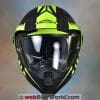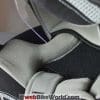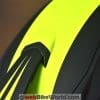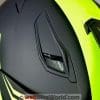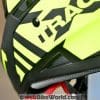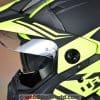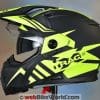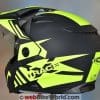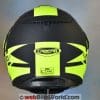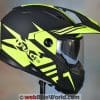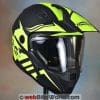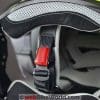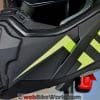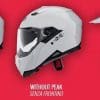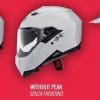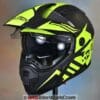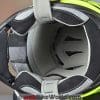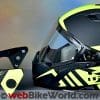We published the Caberg XTrace preview in November 2015.
The helmet was announced at the EICMA show in October 2015.
Call ’em what you want — dual-sport, adventure-touring or Caberg’s “street enduro”, these helmets have become super popular.
But the new XTrace has a slightly different take on the formula.
It’s slightly more biased towards street riding, because truth be told, that’s where about 95% of these helmets get used anyway.
This means that the XTrace is more comfortable for real-world riding, yet it still looks the part for all of the GS jockeys.
It’s relatively lightweight for a dual sport helmet and it has a nice, modern shape and the interior is surprisingly comfortable.
It’s also reasonably priced and although Caberg is turning to Asian suppliers for some of their lower-end helmets, it has good overall quality and the shell feels very sturdy.
Special attention has also been paid to the shell to keep the external dimensions as trim and lightweight as possible.
The extra work has paid off, because the XTrace even in the larger shell size for the XL helmet looks, feels and weighs like everyone else’s size L.
Let’s take a closer look…
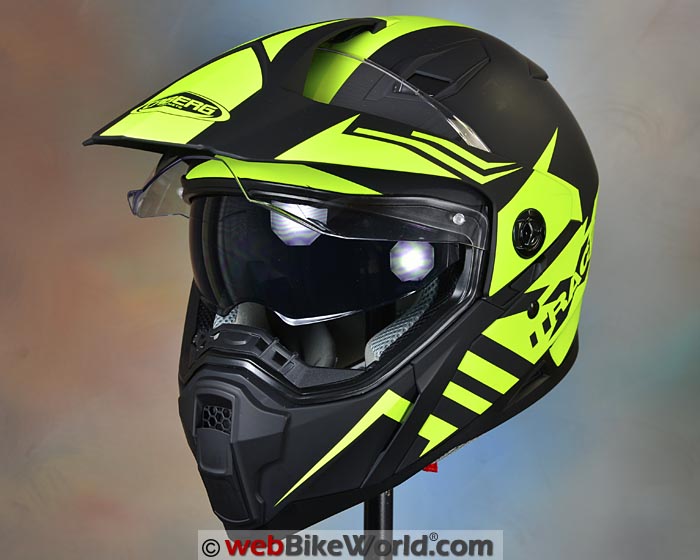
Paint, Graphics and Overall Quality
This XTrace is in the “LUX” high-visibility yellow graphics. The XTrace is currently available only in solid gloss white or matte black and the LUX matte black with yellow graphics.
The high-visibility yellow graphics look good and hopefully add some visibility. The finish is very nicely done, with no quality errors.
The black matte finish can attract oily fingerprints, but they’re quickly eliminated with a quick microfleece wipe.
The moving parts work well, although the overall very subjective feel of this helmet and the recently reviewed Caberg Drift (review) do have that Asian-build feel.
That’s neither good nor bad, here nor there but just something to note.
The fully removable lining is especially comfortable; the fabric feels very soft next to the skin and the padding, while not over-stuffed, also hides all of the corners in the heavily channeled EPS.
Score: The Caberg XTrace has excellent quality. See the ratings descriptions in the summary table at the end of this review.
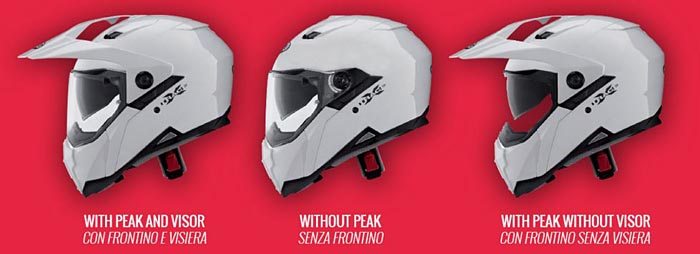
Helmet Fit and Internal Shape
The XTrace has 2 shell sizes to cover the head size range: XS-L and XL-XXL.
Our helmet is an XL and the shell looks and feels smaller than competitor helmets — a good thing.
The internal shape is narrow in the sort of current European fashion.
At first, I didn’t think it would be at all comfortable on my round head, which is widest at the temples but once I squeeze into it, I have no problems even after extended rides.
It’s probably not optimal for round heads and it will leave extra room on the top and at the forehead for roundies, but it works…for me anyway.
The shallow ear pockets are a slight issue, however, because the tops of my ears don’t quite fit and I have to move the helmet back and forth to seat my ears and get my straight-templed sunglasses in place.
The shallow ear pockets should help eyeglass wearers with the head shape that matches the helmet.
Overall, I’d say it feels pretty similar to the current SCHUBERTH C3 Pro (review) internal shape, what we’d call a “Slightly Narrow” to “Narrow” fit.
Caberg says the XL is designed to fit a 61-62 cm head and that seems about right, although a 62 cm head might be stretching it a bit, literally and figuratively.
I haven’t tried a size L but I’m guessing a 60 cm “Neutral” to “Slightly Narrow” head shape will be perfect.

More information on helmet fit can be found in the webBikeWorld Motorcycle Helmet FAQ page.
Also reference the chart that lists the helmet weights of webBikeWorld reviewed helmets and also by shape on the webBikeWorld Motorcycle Helmet Shapes page.
Score: The XTrace gets an “Outstanding” rating for fit and comfort. See the helmet rating scale in the summary table below.
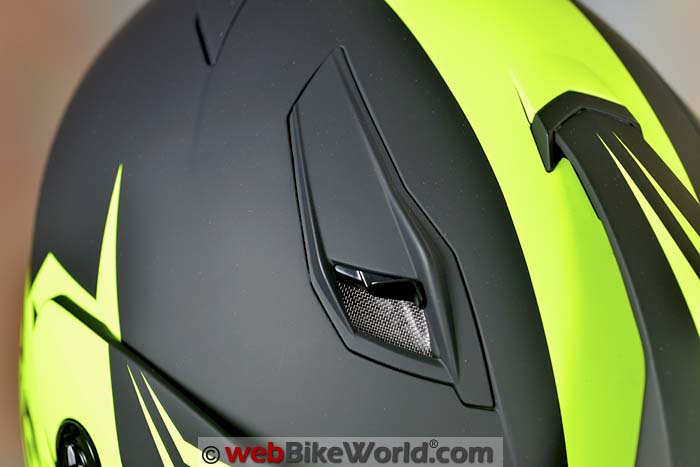
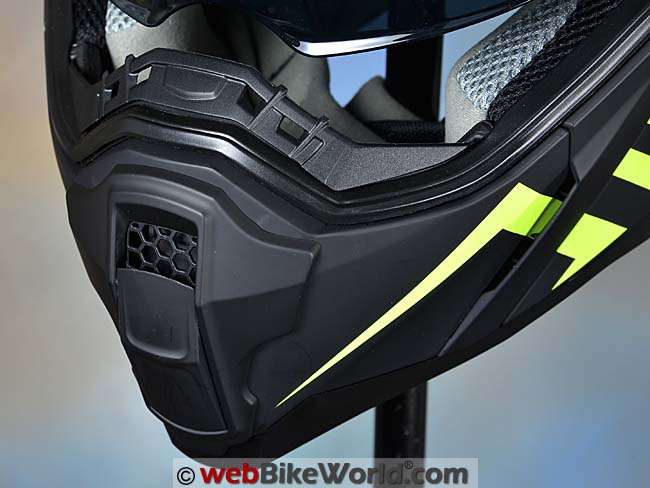
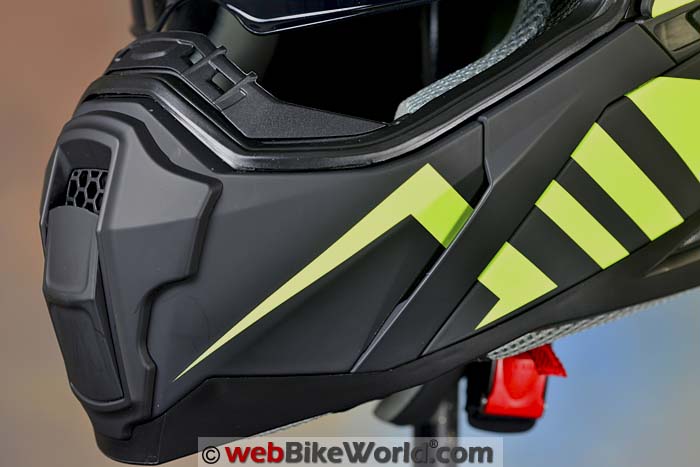
Face Shield, Eye Port and Visibility
The face shield or visor on a dual-sport helmet is a complex shape, which can affect both visibility or clarity of sight and it can affect the way the face shield lifts through the detents.
The face shield on the XTrace seems unusually strong or stiff, so it doesn’t flex much as it’s lifted. There are lift tabs on both sides to move the face shield through its 4 detents.
The optical clarity isn’t perfect though, I notice some waviness or slight distortion in the polycarbonate. Not enough to be bothersome if I don’t focus on it, but if I think about it as I’m looking through, I see it.
The face shield has pins for a Pinlock anti-fog insert, but the insert is not included with the helmet. The outer surface of the face shield is treated with an anti-scratch coating.
Removing the Face Shield and Peak
The face shield attaches with simple plastic-headed metal screws on either side.
The screw-in posts also hold the peak, which is removable and the helmet can be worn as a full-face without the peak.
Be careful not to lose the thin plastic thrust washer underneath the peak though; see the video below for a closer look.
Eye Port and Sight Lines
The eye port provides excellent visibility with nearly unlimited horizontal sight lines. You have to really bend your eyes to either side to see the edge of the eye port at the shell.
Vertical sight lines are excellent also, and over-the-shoulder traffic checks — one of the main benefits of the dual-sport helmet type — are made easy by the big eye port.
This face shield has 4 detents but there’s no small position for defogging. The first opening is pretty large but for some reason, I didn’t feel the need for a defog position anyway.
The face shield closes with a firm “thunk” and it seals tightly across the gasket along the top of the brow, preventing water from entering.
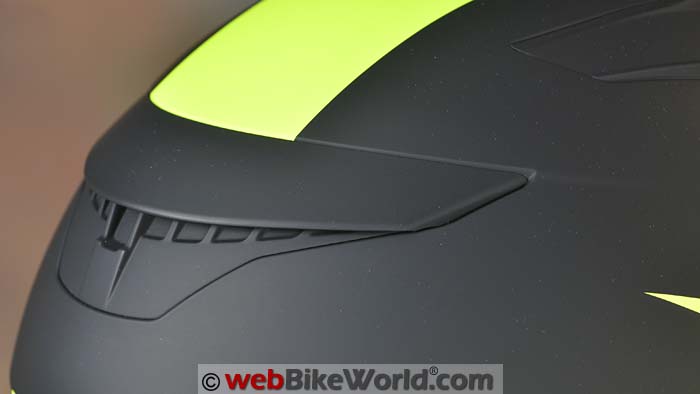
Internal Sun Visor
The internal sun visor operates with a slider on the upper left side of the helmet shell.
The slider is easy to locate and operate, once you practice a couple of times to pinpoint the location with the helmet on and while you’re wearing gloves.
The slider has a smooth but stiff feel and the stiffness or friction helps keep the sun visor in place in an intermediate position.
The best part is that the XTrace sun visor provides outstanding coverage and minimal intrusion into the line of sight.
And one more thing: the XTrace has Caberg’s “Double Visor Tech” feature, which allows the helmet to be worn without the clear face shield and using the drop-down sun visor.
So apparently the sun visor meets the same impact resistance standards as the face shield.
The internal sun visor is treated with an anti-scratch coating and it also seems like it has a darker tint than others we have tried, although I’m not sure how this is possible, as there is a standard for light transmission.
The optical quality is good and — due to the more even curvature — it may actually have less distortion than the clear face shield.
The Peak
The peak on the XTrace is removable (see sections above) and the helmet can be worn as a full-face with or without the face shield.
But removing the peak for the first time is difficult, because it seems that Caberg has applied a slight amount of glue under the plastic cap of the thumb screws that hold the peak on either side.
I couldn’t turn the screw by hand, so I put a cloth over the plastic “X” raised molded part and used a pliers to grab and turn it. Be careful!
Once you break the seal the first time, the screws can be removed by hand the next time.
Also, the receiver that holds the base of the peak at the top of the helmet had a tight grip, so I had to work it back and forth to loosen and remove the peak.
Bottom line? I’d probably use the XTrace as a dual-sport only and forget removing the peak.
The peak also provides very good overhead sun shade coverage and it doesn’t vibrate and it even has very little lift, so it’s a nicely integrated design overall.

Score: The XTrace rates an “Excellent” for the design and operation of the face shield and sun visor and outward visibility.
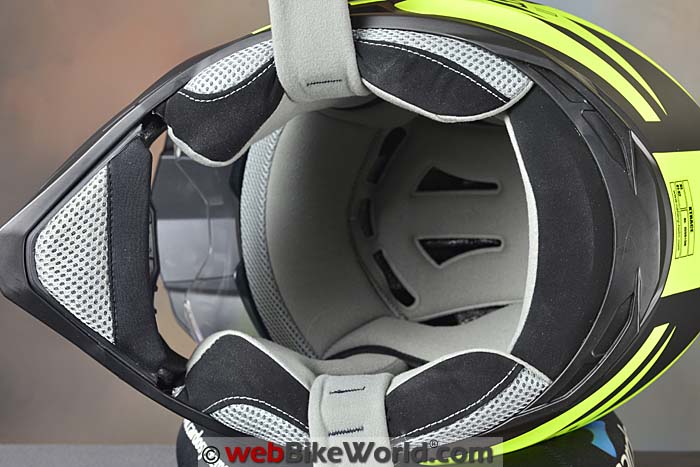
Ventilation
The chin vent system on the XTrace is a bit different from the dual-sport norm.
The large vertical slider in front is difficult to move with bare hands but it’s easier to position when wearing tactile gloves.
Caberg says that the bottom position flows air on to the back of the face shield for defogging, while the top position of the chin vent slider directs air through the slots along the top of the back of the chin bar.
The one thing that’s different about the XTrace compared to other dual-sport helmets is that there’s no direct vent through the chin bar.
While that might seem strange, the XTrace system does seem to work pretty well and the air that flows up through the slots in the top of the plastic that form the molding in the back of the chin bar can be felt by the rider.
The helmet also comes with an installed chin curtain, which helps.
Also, the fact that there is no vent through the chin bar helps with microphone mounting.
Top Vent Notes
The top vents open through two positions and have metal screens at the bottom of a rather deep air passage.
The air flows down into the helmet and through some very deep channels in the EPS that can be seen under the top of the head liner.
Although I can shine a flashlight down through the vents and see a direct passage into the helmet, I don’t feel direct air flow on my head while riding.
The air does flow through and into the channels and directly through to the exhaust vent out the back and the helmet seems to have good ventilation, just that the air isn’t necessarily felt directly on the top of my head.
This may change in winter, however, because the cold air makes a noticeable difference in feel.
Rear Exhaust Vent
The rear exhaust vent is a low profile type and it seems to work well, pulling air through the helmet. I can see a direct outlet through the vent when looking on the inside of the helmet.

Score: Overall, the XTrace gets a “Very Good” rating for ventilation.
Intercom Fit
The shell shape and the way it fits along the bottom of the helmet is fairly standard, so there should be no problems mounting a standard intercom helmet mount.
Sound Levels
The XTrace is slightly quieter than average, with good noise control at the top, especially considering the peak and top vents, which are quiet.
There is some noise around the lower part of the helmet, depending on how the air from a windscreen hits the helmet.
The XTrace feels like it’s cut or shaped at a slight angle at the lower rear and this seems to be the source of the turbulence noise.
In open air, it’s not a problem, but depending on how the turbulent air from a windscreen hits the helmet, some lower frequency “booming” noise can be heard.
Overall, the XTrace does a pretty good job of controlling noise levels, so I’ll rate it as slightly better than average.

Note that our helmet evaluations are a combined effort of several riders over time on different types of motorcycles with and without windscreens.
Evaluators wear correctly fitted, high quality ear plugs (even when evaluating motorcycle intercom systems).
Always protect your hearing when riding a motorcycle. See the wBW Earplug Reviews for more information on choosing and wearing earplugs.
Note also that perceived noise levels will vary, depending on the individual.
Noise can be caused by many factors, including helmet fit, the type of motorcycle and windscreen, wind speed and direction and even the rider’s clothing.
For more information on helmet noise, visit the wBW Motorcycle Helmet Noise page.
Score: I’ll give the XTrace an “Excellent” rating for noise control.
XTrace Helmet Weight
This XTrace in size XL weighs 1663 grams (3 lbs., 10-3/4 oz.), which is relatively light for a helmet of this type.
The trim shape of the helmet shell helps, even though the shell is polycarbonate and not some exotic composite.
All of the weights for full-face, flip-up and open-face helmets are available on the wBW Motorcycle Helmet Weights page.
Also see the chart that lists the helmets by weight and shape on the wBW Motorcycle Helmet Shapes page.
Score: The XTrace gets an “Excellent” rating for its weight but with excellent balance.
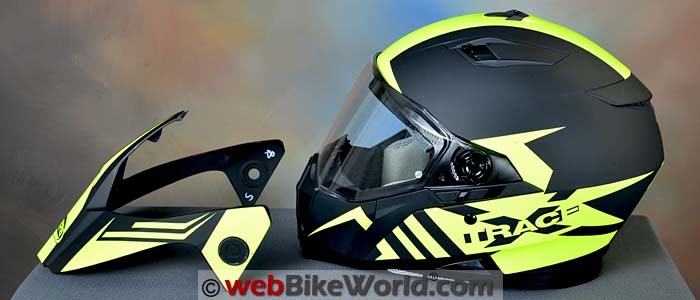
Miscellaneous
The XTrace has a “quick release” micro-adjust style chin strap buckle and the chin strap padding is adequate.
There is no goggle strap holder in the rear, which isn’t an issue really because the XTrace is aimed more at street enduro riders.
The ear pockets are shallow, so thin speakers are necessary if you’re fitting an intercom. But the shallow ear pockets mean that the speakers will be mounted closer to your ears for potentially better sound quality and volume.
The XTrace meets the ECE standard only.
wBW Opinionator: Caberg XTrace
- Styling.
- Build quality.
- Good sun visor coverage.
- Solid feel.
- Usable peak.
- Comfortable liner.
- Face shield optics.
- Minimal color choices.
- No DOT version.
Conclusion
The new Caberg XTrace is an excellent compromise between dual-sport looks and street usefulness.
It’s relatively light, which is a definite plus for this type of helmet and special attention has been paid to keeping the shell dimensions reasonable.
The interior fabric choice and the padding makes the helmet especially comfortable.
The price is reasonable also; the XTrace can be found for around $175.00 USD (plus shipping), which puts the European list price around 150 Euros.
Owner Comments and Feedback
See details on submitting comments.


